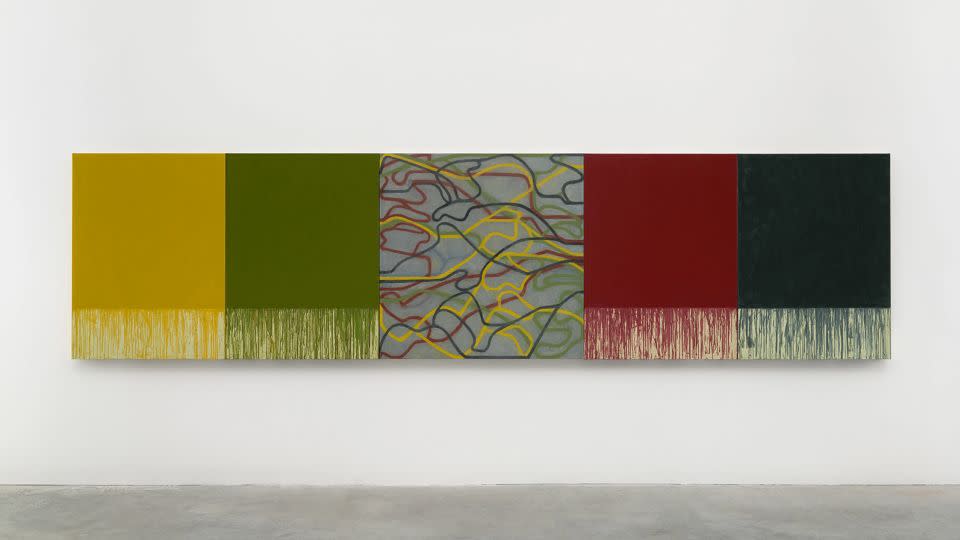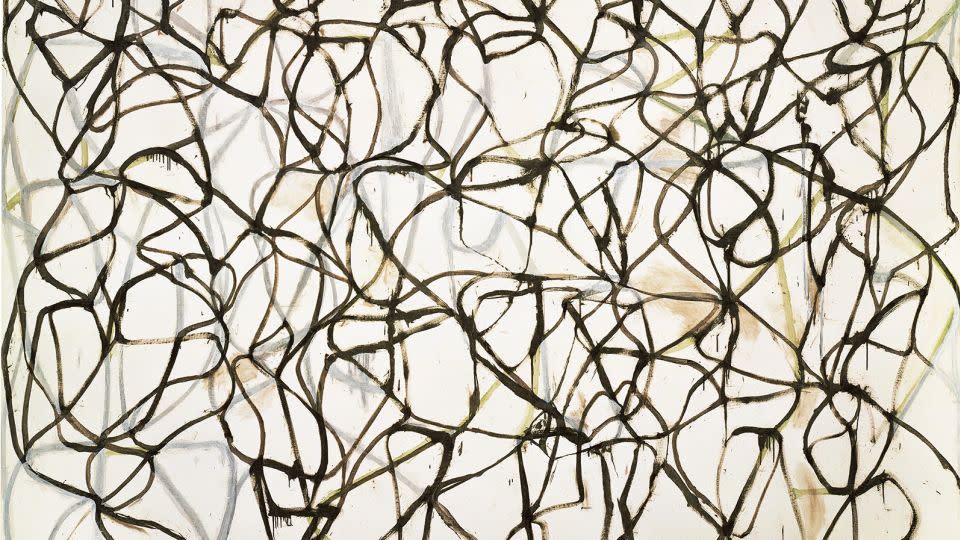Brice Marden, painter revered for his distinctive approach to abstraction, dies at 84
- Oops!Something went wrong.Please try again later.
- Oops!Something went wrong.Please try again later.
Editor’s Note: This article was originally published by The Art Newspaper, an editorial partner of CNN Style.
Brice Marden, the abstract painter known most widely for his long, winding calligraphic mark-making that stood out against monochromatic backgrounds, has died aged 84.
His death was confirmed to CNN by Gagosian, the New York gallery that represented him, via email on Thursday.
The gallery’s founder, Larry Gagosian, added in a statement: “Brice Marden was one of our greatest American artists, whose achievement in continuing and extending the tradition of painting has long been recognized and celebrated the world over. He was a painter of rare insight into the pleasure and poetry of his medium; always dedicated to gesture, chance, substance—the elemental matters of art.”
According to the New York Times, Marden’s wife Helen — a successful painter in her own right — said he died at his home in Tivoli, New York, after years of living with cancer. CNN has reached out to her for comment.

Though Marden was hesitant to discuss his illness at too great a length in interviews, his family had been quite public with his cancer diagnosis over the past six years. In September 2017, his wife photographed him receiving treatment at Memorial Sloan Kettering in New York and posted the images online, continuing to publicly document her husband’s health on her Instagram page.
“I wanted to make it accessible,” she told The New York Times in 2019. “The more you put it out there, the more comfortable people are with it. I also was hoping that by making it public it would help others.”
In the years between his diagnosis and his death, Marden continued to paint prolifically. “I guess I was lucky,” the artist said in the same Times article. “I have been able to work through it all. It hasn’t made me hurry things up. It hasn’t made me work any differently. It’s just been an extra thing to think about.”
Marden was born October 15, 1938 in Westchester County, just north of New York City. He received a bachelor’s degree from Boston University in 1961 before attending Yale for his Master of Fine Arts degree. Marden was part of a historic class of artists to come out of Yale in the early 1960s, with professors that included Alex Katz and Jon Schueler and classmates that included Richard Serra, Chuck Close, Vija Celmins and Nancy Graves.
“When I got to Yale I painted one self-portrait and that was the last figurative painting I ever did,” Marden said in an interview with the Rauschenberg Foundation. “And then I was involved in kind of a reductive sort of situation.”
Marden was part of a historic class of artists to come out of Yale in the early 1960s, with professors that included Alex Katz and Jon Schueler and classmates that included Richard Serra, Chuck Close, Vija Celmins and Nancy Graves.
While at Yale, he would frequently make lists of shows happening in New York and take day trips into the city to see them. After graduating in 1963, he moved to the city with his first wife, Pauline Baez, sister of folk singer Joan Baez. The two lived together in a railroad apartment which Marden also used as a studio. He worked as a guard at the Jewish Museum and was there during its 1964 retrospective of the celebrated American painter Jasper Johns’ career. Johns’ work became a key influence for him, and a departure from the artists whom Marden had previously cited as influences, such as Édouard Manet, Francisco Goya and Francisco de Zurbarán.
Marden was so shy during this period that, when Johns was in the gallery, Marden asked a different security guard to approach the painter to request he sign a poster on his behalf.
Because of his sister-in-law at the time, these early years in the city were also marked by spending time with notable folk singers, including Bob Dylan and Pete Seeger. Marden and Pauline Baez had a son together named Nicholas but soon separated, and by 1968 he had married Helen Marden, whom he had met at the famous New York nightclub Max’s Kansas City, and with whom he had two daughters.

In 1966, Marden had his first solo exhibition, which was held at Bykert Gallery in Midtown Manhattan. He showed a series of monochromatic, oil-and-beeswax paintings — the choice of material was likely influenced by his exposure to Johns’ work — that were met with mixed reviews. That same year, the artist Dorothea Rockburne, a friend of Marden’s, helped him secure a job as studio assistant to Robert Rauschenberg, a position he held for four years.
A trip to Greece in 1971 led to his ongoing series of Hydra paintings, inspired by the dramatic blues of the Mediterranean and the eponymous Greek island, and his work would continue to draw great influence from the natural world for the rest of his life. (A resume on Gagosian’s website lists the artist’s places of residence as New York City; Tivoli, New York; and Hydra.)
By the 1980s, he began experimenting with canvases that featured the winding, intersecting lines that would become indicative of his work, a style that he continued to push and develop in his final years. In 1991, Marden began exhibiting at Matthew Marks Gallery and, in 2017, he moved to mega-gallery Gagosian.
In 2019, the same year he turned 80, Marden unveiled his painting “Moss Sutra With the Seasons” at the Maryland gallery Glenstone, the largest commission of his life. The work serves as a Rosetta Stone to Marden’s visual lexicon. Its multi-panel format invokes a Renaissance altarpiece and the title points to his interest in Eastern thought and painting; its subject alludes to the changing of the seasons and draws inspiration from the moss that can be found throughout the landscape of his home in upstate New York, with the paint itself is doled out in monochrome moments as well as through Marden’s rhythmic, intersecting lines.
For more CNN news and newsletters create an account at CNN.com

